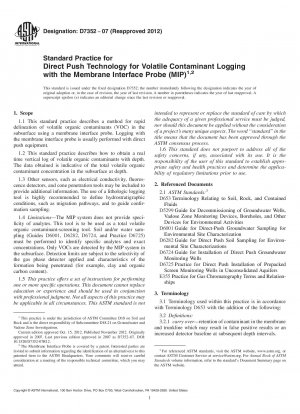ASTM D7352-07(2012)
Standard Practice for Direct Push Technology for Volatile Contaminant Logging with the Membrane Interface Probe (MIP)
- Standard No.
- ASTM D7352-07(2012)
- Release Date
- 2007
- Published By
- American Society for Testing and Materials (ASTM)
- Status
- Replace By
- ASTM D7352-18
- Latest
- ASTM D7352-18
- Scope
- 5. Significance and Use
5.1 The MIP system provides a timely and cost effective way (4) for delineation of volatile organic contaminants (for example, benzene, toluene, solvents, trichloroethylene, tetrachloroethylene) with depth (5, 6). Recent investigation (2) has found the MIP can be effective in locating zones where dense nonaqueous phase liquids (DNAPL) may be present. MIP provides real-time measurement for optimizing selection of sample locations when using a dynamic work plan. By identifying the depth at which a contaminant is located, a more representative sample of soil or water can be collected.
5.2 Correlation of a series of MIP logs across a site can provide 2-D and 3-D definition of the contaminant plume. When lithologic logs are obtained (EC, CPT, etc.) with the MIP data, contaminant migration pathways may be defined.
5.3 The MIP logs provide a detailed record of contaminant distribution in the saturated and unsaturated formations. A proportion of the chlorinated and non-chlorinated volatile organic contaminants in the sorbed, aqueous, or gaseous phases partition through the membrane for detection up hole.
5.4 The data obtained from application of this practice may be used to guide soil (Guide D6282) and groundwater sampling (Guide D6001) or placement of long-term monitoring wells (Guide D6724).
5.5 MIP data can be used to optimize site remediation by knowing the depth distribution of volatile organic contaminants. For example, materials injected for remediation are placed at correct depths in the formation.
5.6 This practice also may be used as a means of evaluating remediation performance. MIP can provide a cost-effective way to monitor the progress of remediation. When properly performed at suitable sites, logging locations can be compared from the initial investigation to the monitoring of the contaminant under remediation conditions.
Note 1???The quality of the result produced by this standard is dependent on the competence of the personnel performing it, and the suitability of the equipment and facilities used. Practitioners that meet the criteria of Practice D3740 are generally considered capable of competent and objective testing/sampling/inspection/etc. Users of this standard are cautioned that compliance with Practice D3740 does not in itself assure reliable results. Reliable results ......ASTM D7352-07(2012) Referenced Document
- ASTM D5299 Standard Guide for Decommissioning of Groundwater Wells, Vadose Zone Monitoring Devices, Boreholes, and Other Devices for Environmental Activities
- ASTM D6001 Standard Guide for Direct-Push Water Sampling for Geoenvironmental Investigations
- ASTM D6282 Standard Guide for Direct Push Soil Sampling for Environmental Site Characterizations
- ASTM D653 Standard Terminology Relating to Soil, Rock, and Contained Fluids
- ASTM D6724 Standard Guide for Installation of Direct Push Groundwater Monitoring Wells
- ASTM D6725 Standard Practice for Direct Push Installation of Prepacked Screen Monitoring Wells in Unconsolidated Aquifers
- ASTM E355 Standard Practice for Gas Chromatography Terms and Relationships*, 2024-04-20 Update
ASTM D7352-07(2012) history
- 2018 ASTM D7352-18 Standard Practice for Volatile Contaminant Logging Using a Membrane Interface Probe (MIP) in Unconsolidated Formations with Direct Push Methods
- 2007 ASTM D7352-07(2012) Standard Practice for Direct Push Technology for Volatile Contaminant Logging with the Membrane Interface Probe (MIP)
- 2007 ASTM D7352-07 Standard Practice for Direct Push Technology for Volatile Contaminant Logging with the Membrane Interface Probe (MIP)

Copyright ©2024 All Rights Reserved

